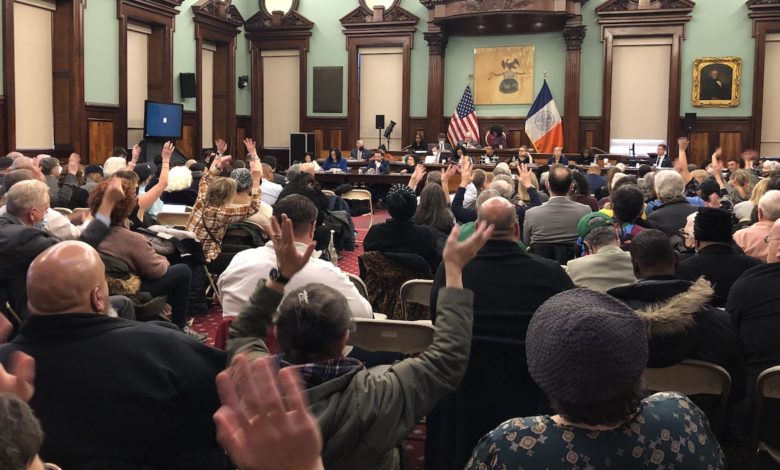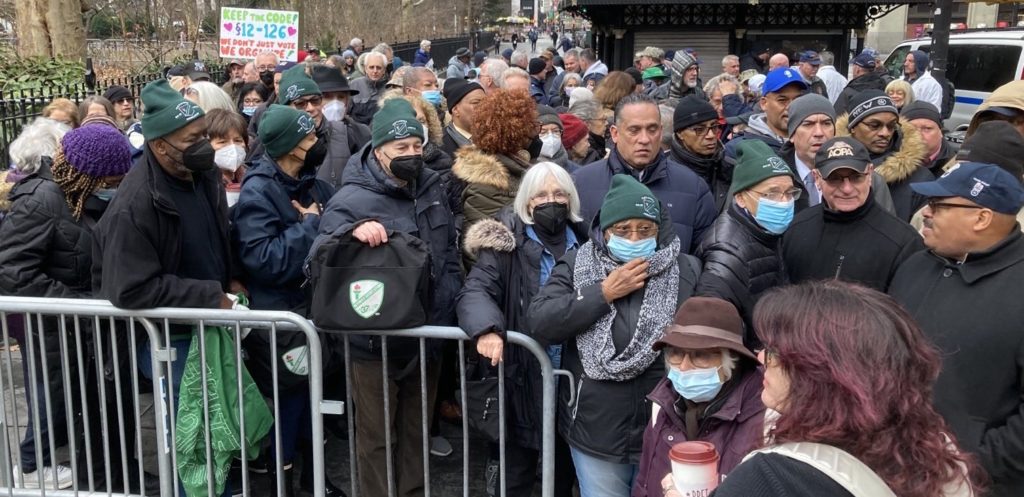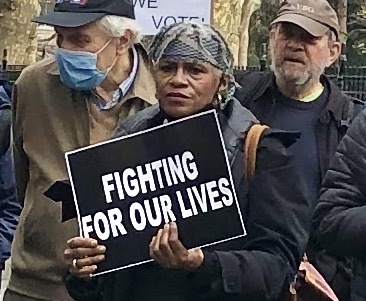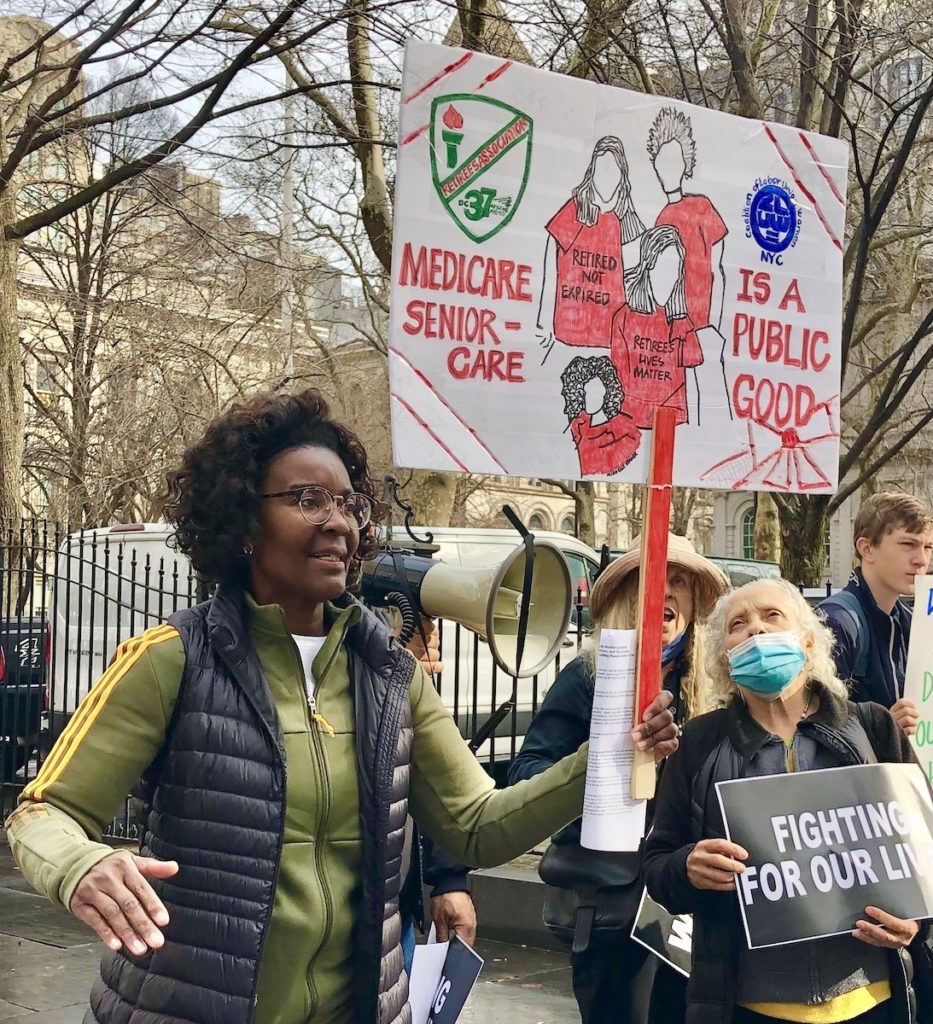
Update March 4: Despite overwhelming opposition, Major Eric Adams plans to take away traditional Medicare benefits for New York City retirees and replace it with a privatized Medicare Advantage Plan run by Aetna that limits their health care options and could even threaten their lives. This affects not only the 250,000 retirees, but also the 1.4 million municipal workers currently on the job, as today’s active worker is tomorrow’s retiree.
The mayor has activated what many are calling the “nuclear option,” making the MAP the only insurance option available for city retirees. Unfortunately, key union leaders are backing the mayor’s plan against the interest of retirees and their own rank-and file. They make up the steering committee of the Municipal Labor Committee, which consists of the trade unions that negotiate with the city.
The MLC will have a full vote on Thursday, March 9, on whether to officially push through the proposed Aetna Medicare Advantage Plan — a measure that would make traditional Medicare unavailable for the roughly 250,000 retired city workers as of Sept. 1.
The NYC Organization of Public Service Retirees is calling on all municipal workers, active and retired, and all their supporters to immediately contact via phone and email the unions in the MLC to demand that they turn down the mayor’s plan on March 9, to let the mayor know that they are against his plan and demand that traditional Medicare, which retirees have already paid for remain an option. Relevant links can be found here.
NYC retirees fight mayor and Wall St., score key victory to keep their health care
New York City retirees just dealt a major blow to Mayor Eric Adam’s plan to downgrade their Medicare. On Jan. 18, due to their struggle, the city council decided not to vote on a bill that would allow the mayor to privatize senior health care, as there were not have enough votes to pass it.
The intensity of this two-year struggle to protect the health coverage of 250,000 municipal retirees was seen on Jan. 9, when more than 500 determined elders packed a council meeting to testify on the proposed bill and urge council members not to pass a law to amend Administrative Code 12-126, which protected their current plan. They filled the 250 seats in the council chambers with 300 more outside chanting “Let us in!” Some 200 signed up to testify. They kept the meeting going for 12 hours as one after another explained how the changes the city is planning to their medical coverage could deny them needed care and shorten their lives.
What was this about?
New York City, the center of world capitalism and the home of Wall Street, is the richest city in the world. There are 107 billionaires living here with over $640 billion in wealth. There are 737 millionaires with over $100 million among the 345,600 millionaires in NYC. They are notoriously under-taxed. Yet, these are the people Mayor Eric Adams is listening to when he announced that a budget shortfall required health care cuts for the city’s 250,000 municipal retirees, whose benefits are only 6/10 of one percent of the city budget.
City administrators never expected retirees to fight back. They forgot that municipal elders are the seasoned union people who, before they retired, negotiated, explained and implemented the very medical benefits the city wants to take away. Retirees across all unions and of all job categories came together. Workers who for decades cleaned this city’s streets and buildings, ran its offices, resolved its medical emergencies, put out its fires, ran its parks and libraries, drove its buses, taught its children and much more formed their own advocacy group — NYC Organization of Public Service Retirees (for Benefit Preservation), one of several senior groups opposing the benefit cut.
Privatized Medicare denies elders needed services
Most city elders have traditional Medicare (tM) as their premium-free plan, as it allows them to choose their doctors, is accepted by the vast majority of doctors and covers the greatest number of medications. The city, claiming a financial shortfall, seeks to downgrade retirees’ premium-free plan to privatized Medicare Advantage Plan, and to charge retirees and dependents $191 per person a month if they want to keep tM.
Medicare Advantage Plans are notorious for denial of care and essential medications and for mandatory pre-authorizations. Being forced into an MAP plan would put New York elders at risk of being denied “medically necessary care,” according to a recent federal study.
Retirees have twice brought the city to court to stop this privatization and to keep their tM. Twice they have won because the mayor’s plan is against the law. Administrative Code 12-126 guarantees retired city workers and their dependents premium-free quality health care for the rest of their lives up to a defined dollar cap. This is an earned-and-paid-for benefit that municipal retirees have had since 1967.
But now the mayor was trying to force City Council to vote to amend that law so he could privatize. That’s why retirees and their supporters were at City Hall on Jan. 9, to persuade the council to vote “no” and leave 12-126 as is.
‘We gave up past wages to get good health care’
Marianne Pizzitola, retired Emergency Medical Technician with the New York Fire Department and the President of the New York City Organization of Public Service Retirees, reminded the council that retirees had already sacrificed for these benefits when they were active workers, including accepting give-backs in exchange for them. “We earned our rights. We earned our benefits, we paid for them. We gave up years of wages. We gave up benefits to have what we have in retirement in the form of deferred compensation.” Elders, she said, “shouldn’t have to worry in retirement, to literally organize and come out and defend themselves.”
AARP: ‘A promise made should be a promise kept’
Also urging City Council to vote against changing the code was Wilson Guzman representing New York City’s 750,000 members of the American Association of Retired People. “Cost savings should not be brought to bear on the backs of retirees,” he explained. Financial hardships “are already faced by our older residents. These hardships already impact housing and hunger. Let’s not add health care to the mix by making it more expensive for retirees to see their doctor. A promise made should be a promise kept.”
Wendell Potter, a former health care executive and well-known whistleblower who used to develop marketing schemes for selling privatized plans, called Medicare Advantage an “enormous cash cow for insurance companies” and “a money making scam … So I implore you to vote not to herd these retires in Medicare Advantage Plans. Doing so will not help retirees get health care, but it will make the bottom line of the insurance companies much healthier with the hard-earned tax money of the people of this city.”
The city is negotiating a private, for-profit plan with Aetna (part of CVS Health). Karen Lynch, CEO of CVS-Aetna received $20.4 million in compensation in 2021.
A life-and-death issue for elders
Hours of individual testimony was given by 200 elders. Some explained how fewer MDs are taking MAPs because these plans make them fight for their reimbursement. One said MAP denied her coverage for a cochlear implant the day before the scheduled surgery claiming this often-done procedure was “experimental” based on a medical opinion from 30 years before. She had to appeal to get the surgery.
A large percentage of testifiers had long-term and chronic conditions now stabilized due to treatment available under tM. If they were denied their doctors or medications it could quickly result in a dangerous health cascade and possible death. Kathleen Cahill, for example, told this reporter she waited 10 hours to tell City Council she has extremely severe osteoporosis, and her tM coverage allowed her to see an endocrinologist at the top of his field who stabilizes her condition with periodic injections. MAP, however, denies coverage for this medication.
MAPs profit by denying coverage
MAPs issue tens of millions of denials yearly, causing “widespread and persistent problems related to inappropriate denials of services and payment,” according to recent government report. MAPs reject services that would probably be approved if the beneficiaries had tM, the report said, delaying and even preventing elders from getting medically necessary care.
In 2020 alone, MAPs defrauded or over-billed Medicare by an estimated $25 billion by saying beneficiaries were much sicker than they actually were. A recent New York Times expose of MAPs entitled The Cash Monster Was Insatiable: How Insurers Exploited Medicare for Billions found that “Most large insurers in the program have been accused in court of fraud.”
Yet, the federal government continues to subsidize these privatized senior plans, promoting their spread. This subsidy is a major reason for the Adams administration’s push to herd retirees into a MAP, as it will leave the city $600,000-a-year richer. Additionally, the biggest stockholders in MAPS are Wall Street financial institutions: Blackrock, Vanguard, State Street, FMR, Capital World, JP Morgan.
Union leaders back mayor’s plan
Unfortunately, the leadership of the city’s biggest trade unions have gone along with the mayor’s MAP plan for seniors, helped formulate it, and tried to sell it to their retirees. They were also in favor of amending 12-126, even though it would leave the door open for health care cuts to the plans of active union members. The Municipal Labor Committee, an advisory body made up of the leaders of the unions that cover city workers, voted to change the law. Out of 103 unions in that group, 48 voted ‘yes’ to amend 12-126, while 11 voted ‘no,’ 4 abstained and 40 were no show.
Some are even telling their active members that if 12-126 isn’t amended, the city will be out of health care funds and they will have to pay $1,500 premiums. The truth is that the funds of one health care source are going down, but are not depleted, and this fund is not the only city source of revenue for health care.
The fund in question is the Joint Health Insurance Premium Stabilization Fund. The city and the MLC jointly decide how the money in this fund is spent.
Since the 2008 Wall Street collapse, the city government, backed by Wall Street, has demanded cuts in health care and other benefits at almost every major union bargaining table. Feeling the pinch in 2014, the Municipal Labor Committee agreed that the city could take $1 billion from the Stabilization Fund to support United Federation of Teachers wage increases. At the same time, Bill de Blasio, the previous mayor, told city workers they had to move down the path to Medicare Advantage for retirees if they wanted to get raises and a contract.
A majority of the Municipal Labor Committee agreed, though this would not have been the preference of any union leader had there been an easy alternative option. Perhaps by their calculations they did not have the capacity and allies at the moment to mount the struggle needed to turn it around.
The funds were to be replaced, but they were not. So the union leaders see the $600,000 in federal funding the city will get if seniors are pushed into a MAP as a way to amend this.
Worker unity needed
Today’s active worker is tomorrow’s retiree. We can’t allow active union members and retirees to be pitted against each other.
This is not a zero sum game. Money in this city is far from scarce, it’s just not available for workers. Overwhelmingly, the city’s 8 million inhabitants would be delighted to see the rich, who benefit from services provided by city workers, taxed at much higher rates not just to ensure senior health care but to repair public housing, improve the subways, lower rents, fund education and much more.
Nearly all major NYC labor contracts have expired, or will this year, and the Adams administration has called for cutback in every area. How union leaders deal with contract talks, mobilizing members and the community for a fight, is important. The options that they have are expanded as the mass struggle is intensified and made more political.
The strategy question right now is how to preserve traditional Medicare for retirees while simultaneously increasing the power of labor collectively for the battles coming in 2023.
Bargaining and the class struggle
Union activists should always be working to mobilize their coworkers, the union and the community around a program to build union power. In bargaining that can mean a program for saving health care and expanding the demand to include free health care for the community provided by public employees — and paid for by taxing the rich and corporations.
With inflation at over 9%, the city’s unions will be surely be demanding larger wage increases than the insulting 2% being offered from the city. They could also call on the city to put extra money in the Stabilization Fund to preserve tM for seniors and for generations to come. Building a stable fund for that should be easy given the potential tax base. Stopping the price gouging by hospitals, a huge reason for the increase in health care costs, would be a popular campaign that could result in regulations to make it a reality. All the major unions have already demanded government relief from hospital price gauging.
None of that happens without organizing. Union activists need to fight to make their unions the best fighters for their members and all labor. At the same time, the best union activists are those with a political vision, who understand that all of this occurs in the struggle between the working class and the capitalist class. Building consciousness from one level to the other is especially important in this period.
The more that we can build that consciousness the sooner we can build the power and structures needed to escape the cycle of budget crisis, concession demands, maneuvers to avoid them, small but important gains here and there — and get onto making real gains.
Right now retirees are the ones fighting for all city workers, and need everyone’s support. An injury to one is an injury to all!








